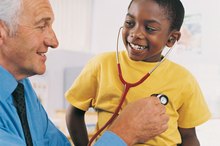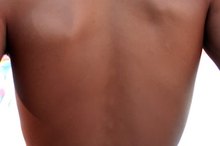What does fact checked mean?
At Healthfully, we strive to deliver objective content that is accurate and up-to-date. Our team periodically reviews articles in order to ensure content quality. The sources cited below consist of evidence from peer-reviewed journals, prominent medical organizations, academic associations, and government data.
The information contained on this site is for informational purposes only, and should not be used as a substitute for the advice of a professional health care provider. Please check with the appropriate physician regarding health questions and concerns. Although we strive to deliver accurate and up-to-date information, no guarantee to that effect is made.
Healthy Weight Calculator for Girls
Girls may develop an unhealthy or even distorted body image when comparing themselves to peers or celebrity figures. Girls and teens develop and grow at different rates, and healthy weight ranges for individual girls constantly shift during adolescence and the teen years. The body mass index offers a reliable model to help you determine if your weight is healthy or if you need to make adjustments.
Factors in a Healthy Weight
Identifying a healthy weight for girls from childhood through the teenage years is a complex process. A girl's healthy weight range can change rapidly due to changes in height and changes in body fat associated with growing and maturing. Body type also is a factor, with some girls being more muscular than others and some being more developed. Use the CDC's BMI calculator for children and teens to help you identify your current weight status, based on your age, weight and height. However, if you're a well-muscled athlete, your weight may not reflect the correct BMI, as muscles weigh more than fat.
- Identifying a healthy weight for girls from childhood through the teenage years is a complex process.
- However, if you're a well-muscled athlete, your weight may not reflect the correct BMI, as muscles weigh more than fat.
Body Mass Index
The Ideal Body Weight for a 7-Year-Old
Learn More
The BMI calculator for children and teens uses a percentile scale to help you understand your current weight status 1. The scale places your BMI in the context of that of other girls the same age, down to the month and day. A BMI that falls in the fifth to less than the 85th percentile represents a healthy weight. Anything below the fifth percentile indicates underweight, whereas a BMI in the 85th to less than 95th percent indicates overweight. Weights in the 95th or higher percentile are categorized as obese, according to the CDC.
- The BMI calculator for children and teens uses a percentile scale to help you understand your current weight status 1.
- Anything below the fifth percentile indicates underweight, whereas a BMI in the 85th to less than 95th percent indicates overweight.
Healthy Weight Considerations
If your weight is categorized as underweight or overweight, your doctor can help you identify a healthy weight target based on your health, your body type and your genetics. Visit your doctor if you are concerned about your weight, even if your BMI indicates that you're in the healthy weight range for your age. Your doctor can provide a more complex assessment and either confirm that your weight is healthy or make suggestions about weight loss or weight gain.
Healthy Weight Loss
Growth Charts for Determining Normal Teen Weight
Learn More
If you do need to lose weight, GirlsHealth.gov., a website from the Office of Women's Health, recommends that you start with increasing your physical activity, which alone may be enough to get you to a healthy weight. When adding exercise is not enough, scale back your consumption of high-calorie foods, enjoying them less often. Balance your favorite unhealthy treats with healthier options, such as fruits, vegetables, whole grains and lean dairy. Avoid skipping meals and eat a minimum of 1,600 calories per day to make sure your body gets the nutrients it needs for healthy growth and development, advises the Office of Women's Health.
- If you do need to lose weight, GirlsHealth.gov., a website from the Office of Women's Health, recommends that you start with increasing your physical activity, which alone may be enough to get you to a healthy weight.
Related Articles
References
- Centers for Disease Control and Prevention: About BMI for Children and Teens
- TeensHealth from Nemours: What's the Right Weight for My Height?
- Gavin ML. Your Child's Weight. KidsHealth from Nemours. Updated June 2018.
- Schleintz D, Bottcher Y, Bluher M, Kovacs P. The genetics of fat distribution. Diabetologia. 2014;57:1276-1286. doi:10.1007/s00125-014-3214-z
- American College of Sports Medicine. Physical Activity in Children and Adolescents. 2015.
- Vispute S, Smith JD, LeCheminant JD, Kimberly S. The Effect of Abdominal Exercise on Abdominal Fat. J Strength Cond Res. 2011;25(9):2559-2564. doi:10.1519/JSC.0b013e3181fb4a46
- Bennett J, Greene G, Schwartz-Barcott D. Perceptions of emotional eating behavior. A qualitative study of college students. Appetite. 2013;60:187-192. doi:10.1016/j.appet.2012.09.023
- Camps SG, Verhoef SP, Westerterp KR. Weight loss, weight maintenance, and adaptive thermogenesis. Am J Clin Nutr. 2013;97(5):990-994. doi:10.3945/ajcn.112.050310
- U.S. Food and Drug Administration. Beware of Products Promising Miracle Weight Loss. Updated January 5, 2015.
- Delimaris I. Potential Adverse Biological Effects of Excessive Exercise and Overtraining Among Healthy Individuals. Acta Medica Martiniana. 2014;14(3):5-12. doi:10.1515/acm-2015-0001
- American College of Sports Medicine. Guidelines for Exercise Testing and Prescription. 10th ed. Riverwoods, IL: Wolters Kluwer; 2017.
Resources
Writer Bio
Pam Murphy is a writer specializing in fitness, childcare and business-related topics. She is a member of the National Association for Family Child Care and contributes to various websites. Murphy is a licensed childcare professional and holds a Bachelor of Arts in English from the University of West Georgia.









